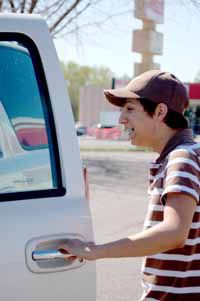| Michael Crespin prepares to go camping over Easter weekend. Crespin reports that his family feels much safer about letting him drive and go away for the weekend because of the fact that his vehicle is equipped with an On-Star system. |
With Easter in the community’s rear view mirror and Memorial Day around the corner, local and national law enforcement agencies remind the teenage driving population about the dangers associated with operating motor vehicles during the summer holidays.
The end of the school year marks the start of the deadliest time of the year for teen drivers, a time when inexperience behind the wheel turns into loss, injury and death for many youths, according to data from the National Highway Traffic Safety Administration.
Stressing that the 101 days from Memorial Day to Labor Day are a time when teen driving, crashes and fatalities all spike, the Summer Safety challenge urges parents to make more time to supervise their teens’ driving, extend the driving privileges gradually, limit passengers and night driving, eliminate distractions and impose strict consequences for safety infractions.
A Drive for Life review of five years of teen-fatality traffic data from the NHTSA confirms the summer months are the most deadly months of the year for teenagers.
Teen deaths increase in May, with 2,568 teen traffic fatalities nationwide between 1999 and 2003 and continue to climb throughout the summer with 2,579 in June.
The teen death toll is highest in July and August (2,786 in July and 2,794 in August) during that five-year period.
By contrast, 2,029 teenagers died in January and 1,789 teenagers died over the same five year period in February, according the National Safe Driving Test and Initiative Web site.
Traffic crashes continue to be the leading cause of death for 15- to 20-year-olds. Not only do teen drivers have higher death rates than older drivers, even teen passengers’ death rates exceed those of older passengers.
According to the Web site, some strategies parents can use to improve their children’s chances of staying safely on the road this summer include:
•Signing a summer contract with their young driver. Parents must make it clear that driving is a privilege, not a right.
Experts urge parents to clearly define the expectations and requirements associated with being allowed to drive and the consequences for violating them.
Carbon County adults should consider the following recommendations:
•Requiring young drivers to sign a contract accepting the conditions and sticking to the guidelines.
•Making time to supervise driving practice.
Driving is a learned skill acquired with much practice.
Teen motorists significantly reduce their risk of crashing if they have logged at least 50 hours of supervised driving before driving alone.
A similar amount of supervised practice is needed before driving alone at night.
•Introducing the driving privilege to teenagers gradually.
Parents should consider allowing independent driving only after much practice and for limited amounts of time and in low-traffic situations on familiar roads.
Adults can grant other privileges, such as driving for longer periods on busier roads, at night, in inclement weather or with passengers later and gradually, as the driver acquires more experience.
•Limiting children from riding with inexperienced drivers.
Children may be in equal or greater danger as a passenger riding with an inexperienced driver.
Many teenagers die as passengers in motor vehicles. And 59 percent of teenage passenger deaths in 2003 occurred in vehicles driven by another teenager.
The site stresses that parents know who is driving their children, what their driving record is like and how their driving is regulated by their parents.
The site further recommends that parents teach their children to be good passengers, avoid distracting the driver and insist on safe driving practices.
Reducing distractions including limiting passengers. Cell phones, radios,compact disk players, mp3 players and passengers all can be deadly distractions.
Parents should express the expectation that children not use a cell phone while driving and regulate the use of music players, restricting music entirely for the first six months of independent driving.
Research confirms that the already increased crash risk for teen drivers rises with each additional passenger.
According to a Johns Hopkins University study, the crash rate is four times higher when there are three or more passengers than when the teen is driving alone.
Teens should be permitted to drive passengers only after the young motorists have gained experience and practice.
The site further recommends that parents limit nighttime and weekend driving. Many teens drive at night for the first time in summer, with the night driving privilege often extended all at once.
Parents should teach teenagers to treat night driving like the new experience it is and allow independent night driving only after significant supervised night driving.
According to the Insurance Institute for Highway Safety, 42 percent of fatal crashes involving teenagers happened between 9 p.m. and 6 a.m. And the later it gets the greater the chance that alcohol is involved.
Finally, the site recommends that parents insist that their children wear safety belts, whether the child is the driver or the passenger.
In general, teenagers are less likely than adults to wear safety belts and failure to buckle up plays a significant role in teen driving deaths.
Additionally, teen drivers are less likely to use restraints when they have been drinking. In 2003, 74 percent of the young driver who had been drinking and were killed in crashes were not wearing safety belts.
Teenagers’ crashes and violations are more likely to involve speeding than those of older drivers and most fatal crashes occur at high speed.
The thrill seeking associated with immaturity (physical and emotional) can overtake what the driver knows to be the right thing to do.
Nearly one-third of drivers ages 15 to 20 who were killed in car crashes in 2003 had been drinking.
Law enforcement stresses that parents require teens to obey the law and revoke privileges if teens speed, act recklessly or drink and drive.

